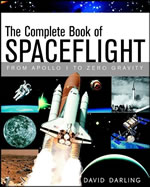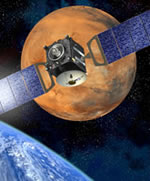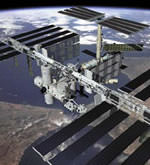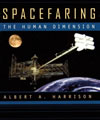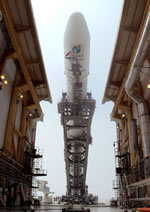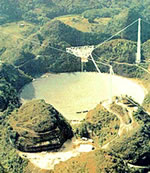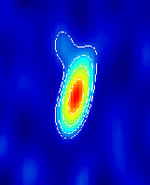
Image credit: NRAO
Gamma ray bursts (GRB) are the largest known explosions in the Universe; immensely powerful, quick to fade, but usually incredibly far away. Astronomers with the National Radio Astronomy Observatory got lucky, though, when they analyzed a recent GRB and discovered it was only 2.6 billion light-years away (most are usually 4 times more distant). What causes these bursts is a mystery, but the theories usually incorporate black holes in some catastrophic way – colliding into another black hole; wrapping a magnetic field like a spring, etc. This close burst didn’t answer the mystery, but it did allow the astronomers to rule out one idea, that material from a GRB blasts out like “cannonballs”.
The closest Gamma Ray Burst (GRB) yet known is providing astronomers with a rare opportunity to gain information vital to understanding these powerful cosmic explosions. Extremely precise radio-telescope observations already have ruled out one proposed mechanism for the bursts.
“This is the closest and brightest GRB we’ve ever seen, and we can use it to decipher the physics of how these bursts work,” said Greg Taylor of the National Radio Astronomy Observatory (NRAO) in Socorro, NM. Taylor worked with Dale Frail, also of the NRAO, along with Prof. Shri Kulkarni and graduate student Edo Berger of Caltech in studying a GRB detected on March 29, 2003. The scientists presented their findings to the American Astronomical Society’s meeting in Nashville, TN.
VLBA IMAGE of GRB 030329
CREDIT: NRAO/AUI/NSF
(Click on Image for Larger Version)
Taylor and Frail used the National Science Foundation’s (NSF) Very Long Baseline Array (VLBA) and other radio telescopes to study the burst, known as GRB 030329. In a series of observations from April 1 to May 19, they determined the size of the expanding “fireball” from the burst and measured its position in the sky with great precision.
At a distance of about 2.6 billion light-years, GRB 030329 is hardly next door. However, compared to other GRBs at typical distances of 8-10 billion light-years, it presents an easier target for study.
“We only expect to see one burst per decade this close,” said Frail.
The precise measurement of the object’s position allowed the scientists to show that one theoretical model for GRBs can be ruled out. This model, proposed in 2000, says that the radio-wave energy emitted by the GRB comes from “cannonballs” of material shot from the explosion at extremely high speeds.
“The ‘cannonball model’ predicted that we should see the radio-emitting object move across the sky by a specific amount. We have not seen that motion,” Taylor said.
The currently standard “fireball model” of GRBs says that the radio emission comes from a rapidly-expanding shock wave. This model was first proposed by Peter Meszaros, Bohdan Paczynski and Sir Martin Rees, who won the American Astronomical Society’s Bruno Rossi Prize in 2000 for their work. In this standard model, as the shock wave expands outward, the emission becomes fainter, but the center of the observed emission does not change position.
The cannonball model, however, proposes that the emission arises from distinct concentrations of matter shot outward from the burst. As they move farther from the burst, their motion should be detected as a change in their position in the sky. On April 3, proponents of the cannonball model predicted a specific amount of motion for GRB 030329 and suggested that the VLBA’s sharp radio “vision” could detect the motion and confirm their prediction.
Instead, “our observations are consistent with no motion at all,” Taylor said. “This is at odds with the cannonball model — they made a specific prediction based on their model and the observations do not bear them out,” he added.
The scientists’ direct measurement of the size of the GRB fireball also will provide new insights into the physics behind the burst.
“By directly measuring the size and the expansion rate, we can start putting some real limits on the physics involved,” Taylor said. First, he said, “We already can confirm that the fireball is expanding at nearly the speed of light, as the standard model predicts. Next, once our May observations are fully analyzed, we can put limits on the energy of the burst and provide a test of the standard model.”
Taylor and Frail observed GRB 030329 with the VLBA on April 1 and April 6. On April 22, they used the 100-meter radio telescope in Effelsberg, Germany in addition to the VLBA. On May 19, they used the VLBA, the Very Large Array (VLA) in New Mexico, the NSF’s Robert C. Byrd Green Bank Telescope in West Virginia, and the Effelsberg telescope.
In addition to gamma-ray and X-ray observations, visible light from GRB 030329 was observed by 65 telescopes around the world. At its brightest, the visible light from this burst was detectable with moderate-sized amateur telescopes.
Gamma Ray Bursts were first detected in 1967 by a satellite monitoring compliance with the 1963 atmospheric nuclear test-ban treaty. For three decades thereafter, astronomers were unable to determine their distances from Earth, and thus were unable to begin understanding the physics underlying the explosions. In 1997, the first distance measurements were made to GRBs, and the NSF’s Very Large Array (VLA) detected the first radio emission from a GRB afterglow.
Once scientists determined that GRBs originate in distant galaxies and that they probably occur in regions of those galaxies where stars are actively forming, some 200 proposed models for what causes GRBs were reduced to a handful of viable models.
Most scientists now believe that GRBs arise from a violent explosion that ends the life of a star much more massive than the Sun. Whereas such an explosion as a typical supernova leaves a dense neutron star, a GRB explosion leaves a black hole, a concentration of mass with gravitational pull so strong that not even light can escape it.
The VLBA is a continent-wide system of ten radio- telescope antennas, ranging from Hawaii in the west to the U.S. Virgin Islands in the east, providing the greatest resolving power, or ability to see fine detail, in astronomy. Dedicated in 1993, the VLBA is operated from the NRAO’s Array Operations Center in Socorro, New Mexico.
The National Radio Astronomy Observatory is a facility of the National Science Foundation, operated under cooperative agreement by Associated Universities, Inc.
Original Source: NRAO News Release
